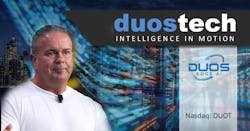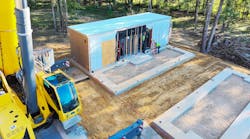Duos Pairs Mobile Power and Modular Edge Data Centers for Rapid Texas Rollout
Key Highlights
- Duos Edge AI is deploying high-density, ruggedized edge data centers across Texas, with plans for 15 units by the end of 2025 to serve underserved markets.
- The company’s mobile power strategy involves behind-the-meter gas turbines, enabling rapid, utility-independent deployment within 90 days, significantly reducing traditional build timelines.
- Duos’ modular, containerized compute pods are designed for quick installation in rural and exurban locations, supporting applications in education, healthcare, and carrier services.
- Leadership additions and patented ruggedization features demonstrate Duos’ commitment to operational resilience and scalable, reliable edge infrastructure.
- Financially, Duos reports strong growth, backed by capital raises and a substantial revenue backlog, positioning it for aggressive expansion and potential profitability in the near term.
Duos Technology Group has launched the fifth of its AI edge data centers, part of a plan to deploy 15 units by the end of 2025. The projects are executed through Duos Edge AI, a subsidiary focused on modular, rapidly installed edge data centers (EDCs) in underserved markets, beginning with school districts and regional carrier hubs across Texas. The newest site is being deployed on-premises with the Dumas Independent School District in Dumas, Texas.
High-Density Edge Design
Duos’ EDCs emphasize very high rack densities (100 kW+ per rack), SOC 2 Type II compliance, N+1 power with dual generators, and a 90-day build/turn-up cycle. Each site is positioned approximately 12 miles from end users, cutting latency for real-time workloads.
To meet the power demands of these edge deployments, Duos formed Duos Energy and partnered with Fortress/APR Energy to deliver behind-the-meter mobile gas turbines. This approach allows compute to go live in 90 days without waiting years for utility interconnection upgrades. The goal is straightforward: move power and compute close to demand, with rapid deployment.
Duos’ modular pods are designed for exurban and rural locations as localized compute hubs for carriers, schools, healthcare systems, and municipal users. The rugged design pairs high-density racks with the short deployment cycle and proximity targeting, enabling a wide range of applications. With Dumas ISD now live, Duos has five sites in Texas, including Amarillo/Region 16, Victoria/Region 3, Dumas ISD, and multiple Corpus Christi locations.
Mobile Power vs. Modular Compute
While Duos doesn’t consistently describe its data center units as “mobile,” they are modular and containerized, engineered for rapid, site-agnostic deployment. The “mobile” label more explicitly applies to Duos’ power strategy—a turbine fleet that can be fielded or re-fielded to match demand. From an operator’s perspective, the combined proposition functions like a mobile platform: pre-integrated compute pods plus rapid-deploy power, available far faster than traditional builds.
A “Mobile” Generation Strategy to Unstick the Queue
North American grid interconnection timelines are often the biggest bottleneck for new compute capacity. Duos’ solution is Duos Energy, working with Fortress/APR Energy to deploy behind-the-meter mobile gas turbines.
The company currently manages an 850 MW fleet of mobile turbines (30 units) through Fortress affiliates. These systems are intended as fast-track power sources for data centers and other customers. By avoiding the need for utility interconnection, Duos can meet its 90-day deployment target for edge data centers.
While Duos does not name customers, the company has disclosed an early project exceeding 100 MW of behind-the-meter turbines for a U.S. AI hyperscaler, with Duos supporting both installation and operation. Other deployments include 150 MW of turbines mobilized in Mexico, further proving the model’s scalability.
This mobile power strategy allows Duos to energize EDC sites immediately, providing localized data center capacity without utility delays. The compute pods themselves are modular and containerized, relocatable in principle, but Duos emphasizes rapid deployment and proximity to users rather than literal mobility. It is the turbine fleet—designed to be fielded and re-fielded as needed—that makes the overall platform truly “mobile.”
Why Care About the Edge?
Duos’ heritage is in machine-vision rail inspection: a business that already required trackside edge compute to analyze 360° imagery of railcars moving up to 125 mph, delivering near-real-time outputs. That long-standing experience with AI inference in rugged environments directly informed the design of Duos’ edge data centers.
Patented Ruggedization
In September 2025, Duos Edge AI was awarded a U.S. patent for a modular data center entryway: a two-door vestibule with enhanced filtration to mitigate dust and moisture intrusion. This clean-room-like design protects sensitive equipment in remote and exurban sites where traditional data center conditions can’t be assumed. Duos positions such design details as critical to proving their EDCs are fit-for-purpose in rural environments rather than just metro extensions.
Density Beyond Typical Edge Boxes
Many competing edge modules top out well below 100 kW per rack, leaning toward micro-colocation or telco functions. Duos is instead pushing GPU-class densities into SOC 2 Type II-hardened, rural-ready modules, coupled with its integrated mobile power strategy. That combination, i.e. high compute density, ruggedized design, and immediate behind-the-meter power, sets Duos apart. And its trackside pedigree of inference at speed in outdoor conditions adds a unique credibility layer as the company expands into education, healthcare, and public safety markets.
Rollout Status and Texas Deployment Roadmap
Duos Edge AI has kept a narrow but focused strategy for its early edge deployments, targeting education and carrier hubs across Texas.
-
2024–2025 launch: Duos Edge AI secured seed financing, tapped edge veteran Doug Recker to lead the business unit, and began initial deployments with Education Service Centers (ESCs) and regional carriers.
-
2025 targets: Company guidance calls for ~15 EDCs deployed by year-end. By Q1, Duos reported 10 units ordered with sites identified.
-
Capital: A combination of a $40M public raise and $12.5M ATM program is funding expansion, with management signaling plans for 50 additional EDCs in 2026.
-
K–12 education: Current sites include Amarillo/Region 16, Victoria/Region 3, and Dumas ISD. These deployments function as localized hubs for real-time learning tools, electronic health records/telemedicine, and regional connectivity, while also serving as carrier meet-me aggregation points.
-
Carrier hubs: Corpus Christi deployments are positioned as central communications nodes supporting mobile operators and enterprise services.
Raymond Brady, Director of Information Technology at Dumas ISD, commented:
“As Director of Information Technology for Dumas ISD, I am excited about our partnership with Duos Edge AI. This collaboration brings direct, on premise access to a cutting-edge data center—an extraordinary opportunity for a rural community like Dumas. It will significantly strengthen the district’s technology capabilities and support our mission of achieving academic excellence through collaboration with students, parents, and the community. I look forward to working with Duos Edge AI as we continue to provide innovative technology for our students and staff, ensuring every student is prepared for success.”
A Pod + Power Option for Realistic Timelines
For customers that can’t commit to hyperscale leases (or can’t afford to wait years for grid upgrades) the combination of a pre-integrated compute pod plus mobile power makes edge capacity procure-able on realistic timelines. The model comes with a smaller CAPEX envelope and shorter payback window, since no utility interconnection is required before go-live.
Ambitious Targets, Early Progress
Hitting the goal of 15 sites in 2025 is ambitious for a new business unit. Nine months in, Duos has deployed five of the 10 units reported as ordered in Q1. Looking forward, the company plans to expand beyond education and carrier partners, with health systems, logistics and ports, and public safety identified as logical next adopters for low-latency hubs.
Will the Model Succeed?
Duos is stitching together rapidly deployable edge compute with rapidly deployable power. Translated beyond Texas, the playbook offers capacity-constrained metros and exurbs a portable mini-fabric of high-density, GPU-ready modules that can be energized in a single quarter. That ability to serve carrier aggregation and real-time local workloads without waiting for the utility queue is the most compelling aspect of the Duos model.
Capital & Outlook: Can Duos Fund 15 EDCs This Year?
Duos’ most recent filings and guidance suggest a company both funded and staffed to accelerate its edge rollout. In Q2 2025, Duos reported 280% year-over-year revenue growth to $5.74M, with first-half revenue of $10.69M: the highest H1 in its history. Growth was driven largely by Duos Energy’s Asset Management Agreement (AMA) with New APR, under which Duos manages a fleet of mobile gas turbines and related inventory for behind-the-meter projects. The AMA also generated high-margin revenue through Duos’ 5% non-voting equity interest in the parent of New APR, recognized as $904K in Q2 and $1.81M in the first half.
As of June 30, Duos reported $40.7M in revenue backlog, plus roughly $18M in contracted backlog and near-term awards anticipated for 2025. Following a $40M public offering and $12.5M ATM raise, management reiterated 2025 revenue guidance of $28–$30M and said the capital position is intended to support 15 EDC deployments in 2025 and ~50 more in 2026. Operationally, Duos placed orders for four additional EDCs in Q2 (10 units ordered year-to-date) and procured 20 backup generators to support near-term siting.
CEO Chuck Ferry also signaled a possible near-term inflection point, saying he expects Duos to record its first breakeven-or-better quarter in company history during the second half.
For buyers, the key takeaway isn’t just a faster box: it’s a provider with cash in hand, backlog visibility, and a power partner aligned to deliver edge capacity on short timelines.
Leadership & IP: Professionalizing the Edge Buildout
It's important to emphasize how Duos is advancing its EDC execution on two fronts: leadership depth and ruggedized design.
-
Executive moves: On Sept. 10, 2025, Duos added Brian J. James—a fiber and data center veteran, now President of NTI—to its board, bringing hyperscale and infrastructure deployment experience. Five days later, Duos elevated Doug Recker (founder of EdgePresence; ex-Colo5) to President of Duos Technologies Group, expanding his role from running Duos Edge AI to shaping company-wide growth across edge and digital infrastructure.
-
Ruggedized IP: On Sept. 3, 2025, Duos Edge AI was awarded a U.S. patent for its aforementioned modular data center entryway: a two-door vestibule with advanced filtration to reduce dust and moisture intrusion, strengthening uptime for rural and exurban installs where exposure risk is higher.
Why does this matter? Edge modules often fail at the seams: access control, filtration, and field hardening. By combining a patented ingress system with a leadership bench that has build-scale-operate credentials, Duos is signaling it intends to compete as a serious EDC provider, not just a niche experiment.
Conclusion: Execution Will Be the Test
Duos Edge AI’s story echoes a familiar theme we’ve seen play out across the data center industry for years: the convergence of vision, capital, and execution. Edge has long been hyped as “the next frontier,” but practical deployments often stumble on the twin barriers of power access and operational resilience. Duos’ approach — coupling mobile power with modular high-density compute, backed by leadership veterans and patented hardening — is one of the more concrete plays we’ve seen aimed at solving those barriers.
As with any ambitious rollout, the test will be execution. Fifteen EDCs in a year is a tall order, and expanding to 50 in 2026 even more so. But if Duos can continue to translate its rail-inspection edge pedigree into repeatable, rapid deployments, the model could have legs well beyond Texas.
The takeaway is straightforward: infrastructure always follows demand. And with AI workloads pushing both latency and power requirements to the edge, Duos is betting its strategy that demand is already here.
Doug Recker on Edge AI and Resilient Infrastructure
As part of its continuing coverage, DCF recently sat down with Doug Recker, President of Duos Technologies Group and founder of Duos Edge AI, for the DCF Trends–Nomads at the Summit podcast series. A telecommunications veteran and edge pioneer with more than 30 years of industry leadership, Recker has played a central role in expanding edge and colocation infrastructure across the U.S.
From founding Edge Presence (acquired by Ubiquity in 2023) and Colo5 Data Centers (later acquired by Cologix in 2014), to deploying more than 40 GE TM2500 mobile turbine units worldwide, Recker has consistently been at the forefront of scalable, resilient infrastructure. His track record includes recognition as one of Northeast Florida’s Ultimate CEOs and leadership of companies named among the Inc. 500’s fastest-growing firms.
In this conversation, Recker reflects on the evolution of edge computing, the lessons learned from decades in telecom and data center operations, and the ways his service in the U.S. Marine Corps continues to shape his leadership philosophy. He also shares how Duos is working to bring multi-access edge data centers (EDCs) to underserved communities, from schools to healthcare facilities.
Tune in for a wide-ranging discussion on innovation, resilience, and the future of edge AI.
At Data Center Frontier, we talk the industry talk and walk the industry walk. In that spirit, DCF Staff members may occasionally use AI tools to assist with content. Elements of this article were created with help from OpenAI's GPT5.
Keep pace with the fast-moving world of data centers and cloud computing by connecting with Data Center Frontier on LinkedIn, following us on X/Twitter and Facebook, as well as on BlueSky, and signing up for our weekly newsletters using the form below.
About the Author

David Chernicoff
Matt Vincent
A B2B technology journalist and editor with more than two decades of experience, Matt Vincent is Editor in Chief of Data Center Frontier.




